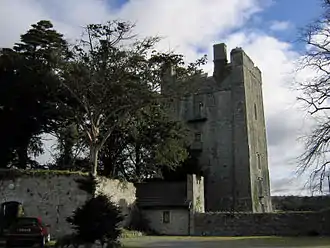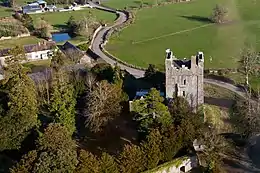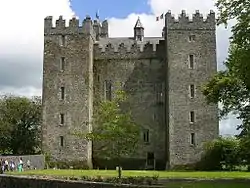Foulksrath Castle
Foulksrath Castle (Irish: Caislean Ratha) is a 14th-century[1] Anglo-Norman tower house located in Jenkinstown in County Kilkenny, Ireland.

History
The castle is closely associated with both the De Frene and Purcell families. The estate and original fortified and moated dwelling were first built in 1349 and occupied by the De Frene family and it is thought that the castle derives its name from Fulco De Frene (d. 1349) who was in the military service of Edward III and fought at the Battle of Crecy and the Siege of Calais. In the early 15th century the current castle was built by the Purcell family, relatives to the De Frene's, after the estate came into their possession.[2][3]
The Purcells sided with the Royalists during the English Civil War and had their estate confiscated by Cromwell. The estate was divided between three officers in Cromwell's army. One of them, Bradshaw, received the castle, but allowed the Purcells to continue living on the land. There were several inhabitants of the castle following Bradshaw's death, including the Dawson family and Moses Henshaw. A family of peasant farmers named Purcell were still living in the castle grounds in 1777 when the castle and lands were let to Thomas Wright. William Ball Wright, noted genealogist and one of the first SPG Anglican missionaries to Japan, was born at the castle in 1843.[4] The Wright family occupied the castle until 1861.[2][5]

The Swift family (relatives of Jonathan Swift) have been associated with the castle since at least 1857. In that year, Godwin Meade Pratt Swift patented the first aircraft in Ireland. He called the device an "aerial chariot" and tested it by launching it from the top of Foulkrath Castle via a catapult with his butler as the pilot. The plane immediately nosedived to the ground. The butler survived, but with multiple broken bones.[6][7] In a 1948 article in the Old Kilkenny Review, John Gibb wrote that the Swift family purchased the castle in 1898.[2] However, in a 1979 article in the same publication, John Brennan suggests they may have been the castle's owners, if not its residents, for a considerable time before that.[3]
In 1910, the castle was let to a Colonel Butler and his sister. After the death of Miss Butler, the castle lay empty and began to fall into ruin.[2] It was purchased from the Swift family by An Óige (the Irish Youth Hostel Association) in 1946 with community support. The purchase and cost of conversion into a youth hostel were met by a public appeal.[1] The Castle was managed by Jack Macken (Ernest J Macken) a well known artist and painter who exhibited his oil paintings (and the work of local artists) in the gallery. Jack Macken left the Castle and the hostel closed in 2009 and Foulksrath Castle is now privately owned.[8]
Architecture
Located about 12 km outside the medieval city of Kilkenny it is a well preserved and restored Norman Tower House. Most of the bawn (outer) wall and some ancillary structures also survive in addition to the main tower. A pitched roof has been added over the centre of the tower, though the open-air walk along the tower's crenellated battlement has been preserved and is still accessible. A narrow spiral staircase connects the four stories. The remains of a moat protect the outer walls of the tower. The moat is believed to have existed since the original structure was built some time in the early 13th century. It is probable that the earlier building was incorporated into the present structure.[2]
Hauntings
Several stories are in circulation as to the haunted nature of the castle and it was visited in 1992 by a BBC television crew of British ghost hunters.[8]
The first legend concerns a female ghost said to look out from the castle windows; she is purported to be the daughter of a former owner of the castle, who, unhappy with his daughter's choice of lover, had her locked away in a tower, where she either starved to death, or was put to death by her father, depending on the version.[9]
The second ghost apparently makes a yearly apparition on 29 November, and is supposedly a guard who fell asleep on duty and was thrown to his death from the ramparts of the castle in punishment. His footsteps can be heard as he wanders the castle to make amends for his carelessness.[10]
The third legend concerns another female ghost, this time a woman who wanders the castle accompanied by the scent of wild flowers, or lilacs.[8]
References
- "Minister to reopen Foulksrath Castle". The Irish Times. 20 October 1962. p. 13.
- Gibb, John S. (1948). "Foulksrath Castle and the families connected with it", Old Kilkenny Review, pp. 47-54. Kilkenny Archaeological Society
- Brennan, John (1979). "Foulksrath and its associations", Old Kilkenny Review, pp. 50-60. Kilkenny Archaeological Society
- "Rev. W.B. Wright of Tokyo". The Library of Nineteenth-Century Photography.
- Wright, William Ball (1887). "On Foulksrath Castle and Logmore, their Founders and Possessors", The Journal of the Royal Historical and Archeological Association of Ireland, Vol. 2, pp. 432-439
- Kilkenny People (20 June 2012). "Swift's Heath"
- See also Excell, John (5 September 2006). "Curiosities from 150 years of The Engineer archive". The Engineer
- Gallagher, Alanna (25 October 2012). "Meet the ghostbusters". The Irish Times
- Buhler, John (1 February 2013). "The Haunting of Foulksrath Castle". The Voice Magazine. Retrieved 7 February 2013.
- "County Kilkenny - Paranormal Database Records". ParanormalDatabase.com. Retrieved 7 February 2013.
| Wikimedia Commons has media related to Foulksrath Castle. |

